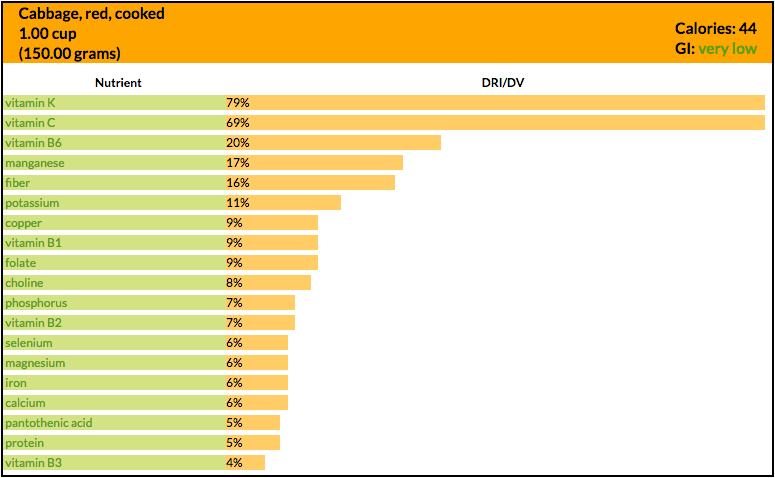|
Cabbage has a long history of use both as a food and a medicine. Prior to the discovery of Vitamin C, sauerkraut (a dish made from fermented cabbage) was treasured by Dutch sailors, who consumed it during extended exploration voyages as they knew it would prevent scurvy. Researchers have observed that cruciferous vegetables, like cabbage, are included among the vegetables that contain the largest concentrations of glucosinolate phytonutrients, compounds that are well established to increase the liver's ability to produce enzymes that neutralize potentially toxic substances. Cabbage is an ideal food to add to your life, not only because it is high in nutrients, but also because it is low in calories, making it great for weight control: one cup of cabbage contains only 44 calories. If you enjoy cabbage, be sure to include it as one the cruciferous vegetables you eat on a regular basis in order to receive the fantastic health benefits provided by the cruciferous vegetable family. At a minimum, include cruciferous vegetables as part of your diet 2-3 times per week, and make the serving size at least 1 1/2 cups. Even better from a health standpoint, enjoy cabbage and other vegetables from the cruciferous family 4-5 times per week, and increase your serving size to 2 cups. Nutrients and Health BenefitsHealth-Promoting Benefits
Selecting Cabbage In order to select the freshest cabbage with the best taste, look for heads that are firm, heavy for their size, and dense with shiny, crisp, colorful leaves free of cracks, bruises, and blemishes. By selecting the freshest cabbage, you will also enjoy cabbage with the best taste and a better chance of high nutritional value. Red cabbage has much more flavor and six times more antioxidants than green cabbage. As with all vegetables, it is recommended to select organically grown varieties when possible. Avoid purchasing cabbage that has severe damage to the outer leaves as this is suggestive of worm damage or decay that may reside in the inner core as well. There should be only a few outer loose leaves attached to the stem. If not, it may be an indication of undesirable texture and taste. Avoid buying precut cabbage, either halved or shredded, since once cabbage is cut, it begins to lose its valuable vitamin C content, and glucoraphanin (a glucosinolate) is converted to sulforaphane (a highly reactive isothiocyanate that has been observed to reduce oxidative stress and inflammation by activating the Nrf2 transcription factor). Storing Cabbage It is encouraged to consume kale as soon as possible after purchasing it for the most flavor and nutritional benefits. The longer you keep it the more nutrients you lose. Prevent cabbage from turning yellow, losing its sweet flavor and nutrients, and becoming limp and bitter. To keep it fresh, store cabbage no more than 10 days. Many factors affect the shelf life of cabbage. Respiration rate is one of them. Cabbage continues to respire (break down sugars and release carbon dioxide) even after being harvested. Reducing the storage temperature reduces the respiration rate. Store cabbage within a airtight container in the refrigerator. While whole-head cabbage can be stored for 2 weeks, a partly cut cabbage should be tightly covered and kept for no more than 3-5 days. Red and green cabbage will keep for about 2 weeks if stored properly, while Savoy cabbage will keep for about 1 week. Preparing Cabbage Rinse under cold running water before removing the thick fibrous outer leaves and cut the cabbage into quarters. No need to rinse after cutting because the interior of cabbage has never been exposed to the outside environment. Cutting cabbage into slices of equal thickness will help it cook more evenly. Because thinly sliced cabbage cooks more quickly, it is recommended to cut cabbage into 1/8-inch slices. Before slicing it, first quarter it and remove the core to make the process easier. Let slices sit for 5-10 minutes before cooking to bring out their hidden flavor and nutritional benefits for maximum enjoyment. Since phytonutrients in the cabbage react with carbon steel and the leaves turn black, use a stainless steel knife to cut. Cooking Cabbage Cabbage is a hearty vegetable, which should be cooked just long enough to soften its fibers for better digestion and overall greater enjoyment. Because cabbage is such a valuable food that can make a fantastic contribution to our health, it is important to cook it properly and preserve it's panoply of nutrients. Researchers have well established that improper cooking, too much heat and long cooking times, can easily damage many nutrients present in cabbage. The most nutritious way to cook cabbage is to sauté it for only 5 minutes. Use exact cooking times, and avoid using high heat. Vegetables, such as cabbage, can continue to cook if they are left in the pan after the heat is turned off. Therefore it is suggested to immediately remove cabbage from the pan to prevent overcooking. ReferencesMateljan, G. (2018). Cabbage. [online] Whfoods.com. Available at: http://www.whfoods.com/genpage.php?tname=foodspice&dbid=19 [Accessed 5 May 2018].
Mercola, J. (2018). What is Cabbage Good For? - Mercola.com. [online] Mercola.com. Available at: https://foodfacts.mercola.com/cabbage.html [Accessed 5 May 2018].
0 Comments
|
This portal contains research, news, information, observations, and ideas at the level of self in an effort to address lifestyle applications.
Archives
June 2024
Categories
All
|



 RSS Feed
RSS Feed

